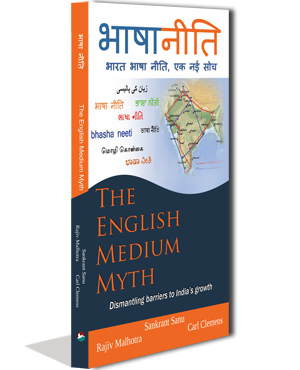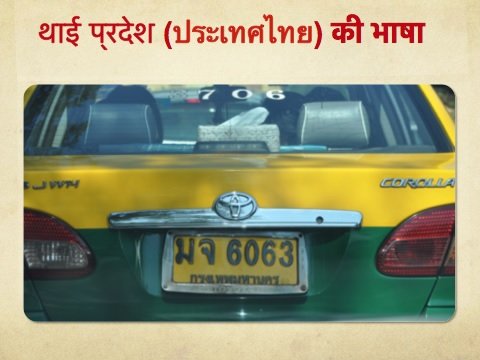




@sankrant संक्रांत जी का उत्तम लेख दैनिक जागरण में प्रकाशित हुआ देख
कर हृदय आह्लादित हुआ | समय आ चुका है जब हम भारतीयों को अंग्रेज़ी का दासत्व अंततः त्याग कर अपनी-अपनी मातृभाषाओं का गर्व से, अधिकाधिक प्रयोग प्रारंभ करना चाहिए |

Articles by Sankrant Sanu

IndiaFacts Hindu Human Rights Report launched at New Delhi: A Report | IndiaFacts
https://bharatabharati.wordpress.com/2015/02/15/delhi-turns-its-back-on-the-bjp-sankrant-sanu/

Angreji Madhyam Ka Bhramjaal

Here Are 5 Myths About English That All Indians Should Stop Believing Right Away
Aug 09, 2016 at 18:21
by https://scoopwhoop.com/author/sankrant-sanu/
Recently, Uma Bharti remarked on the need to propagate Indian languages and how English becomes a barrier. Predictably, people on English news portals jumped on her remarks.
Sample a comment on one such portal:

There are some enduring myths about the English language in India, particularly in association to “progress”, “technology” and “modernity”. As someone who went to an English-medium school in India, I myself subscribed to these myths. It was only when I traveled the world, to over 30 countries, that I realized our assumptions about English are that of frogs in a well.
When I was a manager at Microsoft, I visited my team at the Microsoft development center in Israel. This was eye-opening. I later spent a summer traveling in Indian villages and I realized the real cost of our assumptions about English. Contrary to the notions I had about English is necessary for science and technology or for India’s progress, I came to realize that India’s English-medium obsession is one of the biggest barriers to India’s development.
Here then are 5 enduring myths about English:

India’s English-medium obsession could be one of the biggest barriers to India’s development / Reuters
- Myth 1: English is a language spoken by all well-educated, developed, technically-savvy people in the world
There are millions of people in the world who are well-off, well-educated and technically savvy and they don’t speak a word of English. When I was in South Korea, I found it to be an affluent country. However, it was nearly impossible to find someone who spoke English apart from the staff of the luxury hotel I was staying in. In China, I found a tech-savvy population and a proliferation of high-end iPhones. Yet, even at a fancy restaurant in Beijing, I found that not one person—from the wait-staff to the manager—spoke a word of English. I can’t imagine something like this happening in India. The staff at the Chinese restaurant asked me to type my order into their smartphone. They then used the Baidu app to translate it into Chinese.

(Left) Ad for Audi in Beijing is not in English. Ad for multinational bank HSBC is in Turkey. Photo: Sankrant Sanu
- Myth 2: MNCs do all their business in English; English is necessary for an MNC job

MNCs in all major countries operate in the local language. When I was at the Microsoft Development Center in Haifa, Israel, I was surprised to find that the language of communication was Hebrew, not English. Emails were in Hebrew, technical documents and discussions were all in Hebrew. This, when the entire population of Israel is less than that of Delhi. Similarly, Samsung, which is one of the biggest electronics manufacturers in the world with cutting-edge technology has a CEO who did his MBA in Korean. Samsung uses Korean in South Korea, uses Thai for office jobs in Thailand, but in India it uses English. MNCs choose to adapt to different countries of the world but in India, we bend backward assuming MNC means English.
Car number plates in Thailand. Notice Devanagari-like script. Photo: Sankrant Sanu.
- Myth 3: English is India’s “competitive advantage” and necessary to develop India
This is the most enduring myth—that English has given India a “competitive advantage” in Information Technology. There are highly technically advanced societies, such as Japan, that do not use English. Some years ago I traveled to Indian villages armed with IQ tests. I found, to my surprise, that rural children outscored urban Indian children in IQ. English, as the language of higher and professional education, alienates these children. They find math easy but English hard.

Chinese use local language in technology. For representation /Reuters
Even when it comes to outsourcing, the advantage is temporary. China’s programmers learn in Chinese and have teams with one outward-facing project liaison who speaks the client language. Thus, China is providing outsourcing to the US, using English, but also to Japan, using Japanese. Only about 5% of the world’s population is native English speakers and the importance of this segment will likely decline as the US and the UK decline as Economic superpowers. China is also investing in technological innovation, developing its own companies, like Baidu and Weibo for search and social networking while its entire technology education uses Chinese.
- Myth 4: Indian languages are “not suitable” for science and technology education
Science is taught at the graduate level in dozens of languages across the world, from Japanese to Portuguese and from Thai to Polish. It is even written using the pictographic Kanji (Japanese writing system) script with thousands of characters. Even MS-DOS the command prompt operating system from Microsoft supported Kanji characters 30 years ago because the Japanese demanded it.

In Japan, students learn science in local language / Reuters
Indian languages, on the contrary, are highly scientific. They are phonetically sound and can express a range of sounds. They also have technical literature and vocabulary for hundreds of years. Sanskrit-based grammars also make it very easy to construct new words.
Hebrew was once considered a dead language, yet it was revived for science and technology education. Technion, Israel’s foremost engineering college is Hebrew-medium and is ranked much higher than the IITs. Languages need investment. India simply needs to invest in its languages and keep them contemporary. It is much easier to translate one thousand key books on science and technology than teach a foreign language to a billion plus people.

Students at The Technion-Israel Institute of Technology / Facebook
- Myth 5: People want English, but the government keep pushing Hindi/Indian languages
It is, in fact, the other way round. It is English that is pushed in India by government policy. The government allows only English in the Supreme Court and most High Courts. Most top institutes, be it the IITs, the IIMs or the AIIMS, they are all funded by the government and operate only in English. Most government websites still use English as the primary language. But is this because people want it?
No, where people have a real choice, they prefer to consume Indian languages, not English. Only one of the top 10 newspapers in India is in English. As a percent, less than 10% of the newspaper readers prefer to read in English. English TV channels have an even smaller percentage of the audience. Thus, given a choice, most people would rather read and listen to their own languages.

It is the vernacular newspapers, and not the English language ones, that rule the market in India.
The demand for English arises because of flawed government policies that are pushed by the elite. We need to provide an equal opportunity to study Indian languages. This will allow deep technology penetration. English cannot be the vehicle for our development, rather it remains the biggest barrier to our progress.
——————————————————————————————
The English Medium Myth
[PDF]Languages of Nationhood: Political Ideologies and the … – UR Resear
[PDF]chapter -ii justice party and its language policy – Shodhganga
School Text Books – OoCities
——————————————————————————————
शिक्षा अधिकार क़ानून (आर टी ई) पर दैनिक जागरण में आज मेरा लेख।@realitycheckind

Twitter Chat about education in India
Scientific Research consistently has shown that children learn better in their mother tongues. Yet the Indian govt’s #EnglishApartheid policies creates a mad rush to English-medium, destroying talent, minds, and culture. @narendramodi
Children Learn Better in Their Mother Tongue
Children Learn Better in Their Mother Tongue
Globally, there are 50-75 million ‘marginalized’ children who are not enrolled in school. Children whose primary language is not the language…
globalpartnership.org

एअर कनाडा को हिंदी के प्रयोग में कोई परेशानी नहीं। वह पंजाबी में भी बोलते हैं। लेकिन भारत में आते ही हवाई अड्डे से ही अंग्रेज़ी ही सब जगह दिखती है।

दुनिया बहुभाषीय है। जब सब जगह अंग्रेज़ी ही झलकती है तो समझ लो की “भारत” पहुँच गए।


Sankrant Sanu सानु Retweeted Anant Goenka
सबसे बड़ी परेशानी हमारी मानसिकता की है। हमारी ग़ुलाम मानसिकता ने अंग्रेज़ी को उच्च मान लिया। यह मानसिकता दशकों की भारत सरकार की नीति और भेदभाव का परिणाम है।
3 ppl on business class London to Mumbai reading newspapers that are in either Hindi or Marathi (NBT, Loksatta). In Europe we also often see passengers reading French/German newspapers..we must get over the idea that local language media doesn’t target a higher income audience.

——————————————————————————————
Sankrant Sanu सानु Retweeted Abhishek
No surprise. Just like the colonial courts the patent office of the slave Republic of India does not allow patents to be filed in any Indian language. @narendramodi @drharshvardhan

Maodas Macaulayputra @Macaulayputra
Sankrant Sanu सानु @sankrant Aug 2
I met a village boy who wanted to do industrial design. Couldn’t surmount AutoCAD being in English. Now drives a taxi.
Evolved Monkey @evolvedmonkey82
HiPAC @HinduPAC
Priyank @priyank_ks
ASHOK SINGHAL @shoksing
@rahuldev2 @sankrant wouldn’t GST will worsen it by forcing invoicing in English which may be difficult for many state babus & shopkeepers
Sankrant Sanu सानु @sankrant Aug 5
——————————
————————–
Priyank @priyank_ks
vishwamohan @mycobacteriuma
Abhijit Majumder @abhijitmajumder
AB @absrkr

-
English as a class marker is deeply embedded in the #AdarshLiberal psyche. http://sankrant.org/wp-content/uploads/2011/03/The-English-Class-system-in-SALR1.pdf … @BDUTT @nikhilesh01 @madhukishwar
-
Did @BDUTT understand root meaning of anathema in her tweet? Did @nikhilesh01 in his #EnglishHubris?
 @madhukishwar——————————————–
@madhukishwar——————————————–
-
It’s a rotten education system that churns out tens of thousands of educated masses who are clueless about the fundamental basics of their democracy.
-
Parents to blame too. We want our kids to be engineers, docs, managers, CAs, whatever. But we fail in teaching them to be informed, citizens.—————————The “New” education policy is so flawed, bureaucratic and outdated that it’s difficult to critique in bits. The babus just don’t get it.We need an enabling-framework rather than a restricting one. Completely decentralize public education, dismantle state-level bureaucracy 2/nProvide direct tax for local schools with local accountability. Hire for specific schools so a village is not a “hardship” posting. 3/nRemove all RTE “infrastructure” requirements for schools. Let a million flowers bloom. Create minimum learning outcomes to meet. 4/nDismantle #EnglishApartheid in Higher and Professional end. Fund #IndianLanguage higher ed at par with any English IIT/IIM/AIIMS etc. 6/nThe #NEP
 ‘s “solutions” are the exact opposite. It thinks bureaucratic monitoring and control will fix education. Trust people, not govt. 7/nThe genius of India can never be unlocked by centralized control. We are destroying minds by creating education scarcity via controls… 8/nWe cannot convert a billion+ people to a foreign language for higher and professional education. #EnglishApartheid holds us back. 9/nGovt-funded #EnglishApartheid forces rote learning and lack of comprehension destroys #DemographicDividend, kills #SkillIndia. 10/nWe need a grounds-up re-imagination of education to seize the tremendous opportunity for truly developing & revitalizing our minds.Our schools don’t teach basic skills. Colleges teach nothing of value. “Social sciences” break society. We do little relevant research 13/nBut our bureaucrats have produced a “new” education policy whose innovative idea is to “merge” distant schools to meet RTE infra norms 14/nNow we’re expected to provide feedback on the band-aids they’ve stuck to cure cancer. Maybe merging two bandaids will fix it? n/n @sankrantDismantle #ReligiousApartheid in education. People should not be penalized for belonging to one religion or another. Create le————————————————————————————Twitter Chat about education in other countriesShef @desitechy“much easier translating 1000 key books of science +tech to Indian languages than teach English to 1 billion+ Indians. Well Said @sankrantIt’s a one-gen problem. I asked an EE student in Poland about translation. He said their Profs write books. In Polish.————————————-जापान अग्रिम गाड़ी-उत्पादक बना जापानी भाषा में, सैमसंग वैश्विक इलेक्ट्रॉनिक कोरियन, इज़्रेल हाई-टेक हीब्रू में। भारत पिछड़ा अंग्रेज़ी में।———————–most countries top MNC jobs are in local languages. #SlaveIndia stuck with English.———————————–
‘s “solutions” are the exact opposite. It thinks bureaucratic monitoring and control will fix education. Trust people, not govt. 7/nThe genius of India can never be unlocked by centralized control. We are destroying minds by creating education scarcity via controls… 8/nWe cannot convert a billion+ people to a foreign language for higher and professional education. #EnglishApartheid holds us back. 9/nGovt-funded #EnglishApartheid forces rote learning and lack of comprehension destroys #DemographicDividend, kills #SkillIndia. 10/nWe need a grounds-up re-imagination of education to seize the tremendous opportunity for truly developing & revitalizing our minds.Our schools don’t teach basic skills. Colleges teach nothing of value. “Social sciences” break society. We do little relevant research 13/nBut our bureaucrats have produced a “new” education policy whose innovative idea is to “merge” distant schools to meet RTE infra norms 14/nNow we’re expected to provide feedback on the band-aids they’ve stuck to cure cancer. Maybe merging two bandaids will fix it? n/n @sankrantDismantle #ReligiousApartheid in education. People should not be penalized for belonging to one religion or another. Create le————————————————————————————Twitter Chat about education in other countriesShef @desitechy“much easier translating 1000 key books of science +tech to Indian languages than teach English to 1 billion+ Indians. Well Said @sankrantIt’s a one-gen problem. I asked an EE student in Poland about translation. He said their Profs write books. In Polish.————————————-जापान अग्रिम गाड़ी-उत्पादक बना जापानी भाषा में, सैमसंग वैश्विक इलेक्ट्रॉनिक कोरियन, इज़्रेल हाई-टेक हीब्रू में। भारत पिछड़ा अंग्रेज़ी में।———————–most countries top MNC jobs are in local languages. #SlaveIndia stuck with English.———————————–Maodas Macaulayputra @Macaulayputra
@sankrant Overvalued English breeds low self-esteem among all strata in every aspect. From the meek MEA babu to an auto-driverअंग्रेज़ीवाद के कारण यह आत्मसम्मान का अभाव चीन जैसे देश में नहीं दिखता। वह हमसे कहीं आगे निकल रहे हैं।—————————-CC @Satyanewshi
@sankrant @BJP4India I don’t agree to beg good in English is our competitive advantage which China and Japan don’t have.How Chinese learn how to program. A few keywords different from the medium. http://www.bhashaneeti.org/wp-content/uploads/2014/07/%E7%AE%80%E6%98%8EPython%E6%95%99%E7%A8%8B.pdf …English is such an “advantage” that we’re far behind Japan, and even China is surging ahead in software & technology https://twitter.com/Satyanewshi/status/755288525604425730 …———————–
Spatel @RjrasvaThe Japan That Can Say No by Akio Morita & Shintaro Ishihara, 1989 -Morita was Sony chairman, contrast N Murthy etcअंग्रेज़ी की ग़ुलामी सभ्यता की ग़ुलामी को सींचती है। https://twitter.com/rjrasva/status/724549575508258816 … @desitechy———————————-@sankrant @birajanath I have worked with Chinese in Chittagong Fert during shutdowns. They know no English/Bangla yet do such a marvelous jobk Sankaranarayanan @skarpa23I had worked with a Chinese s/w vendor. Some of their best programmers, designers know only Chinese & proud of it https://twitter.com/sankrant/status/773877002898202625 …Absolutely. I’d hired programmers from Russia at Microsoft US who barely knew any English. Some of my best hires.———————————————People in Korea are using high-tech smartphones in Korean, China in Chinese. India has #EnglishApartheid barrier.———————————–Own smartphone S Korea 88% Australia 77% Israel 74% US 72% Turkey 59% China 58% France 49% Japan 39% India 17% China, using Chinese, is zooming ahead in Artificial Intelligence research. We are happy to get call-center jobs. Because
China, using Chinese, is zooming ahead in Artificial Intelligence research. We are happy to get call-center jobs. BecauseChina has shot far ahead of the US on deep-learning patents
Chinese companies are registering for more AI patents than their American peers, including in the advanced subset of AI called deep-lea…
qz.com
————————————————————————————
Mother tongue or English? What should be the medium of education?
Problematising Hindi as the ‘Self’ and English as the ‘Other’




 Sankrant Sanu सानु
Sankrant Sanu सानु 
 HiPAC
HiPAC  Dr.Sammod Acharya
Dr.Sammod Acharya  ಪ್ರಭಾಕರ ಮೇಟಿಕುರ್ಕೆ
ಪ್ರಭಾಕರ ಮೇಟಿಕುರ್ಕೆ  KiranADamle क्षकिरण
KiranADamle क्षकिरण  Shirish Sharma
Shirish Sharma 
 Conrad Hackett
Conrad Hackett
